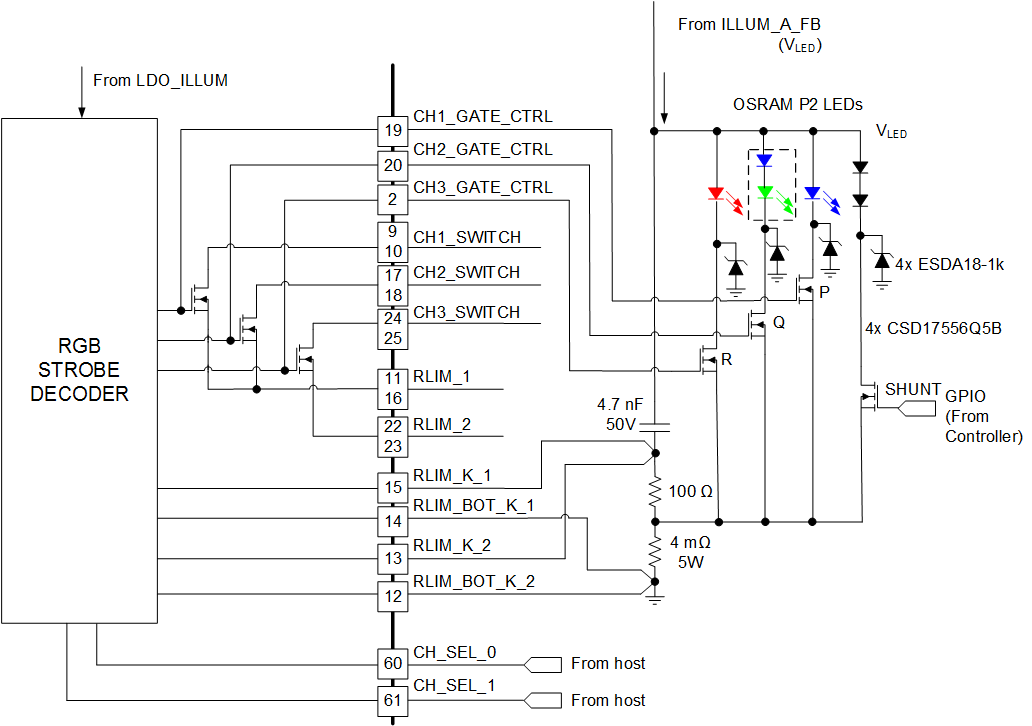DLPS132 May 2018 DLPA4000
PRODUCTION DATA.
- 1 Features
- 2 Applications
- 3 Description
- 4 Revision History
- 5 Pin Configuration and Functions
- 6 Specifications
-
7 Detailed Description
- 7.1 Overview
- 7.2 Functional Block Description
- 7.3
Feature Description
- 7.3.1 Supply and Monitoring
- 7.3.2 Illumination
- 7.3.3 External Power MOSFET Selection
- 7.3.4 DMD Supplies
- 7.3.5 Buck Converters
- 7.3.6 Auxiliary LDOs
- 7.3.7 Measurement System
- 7.4 Device Functional Modes
- 7.5 Programming
- 7.6 Register Maps
- 8 Application and Implementation
- 9 Power Supply Recommendations
- 10Layout
- 11Device and Documentation Support
- 12Mechanical, Packaging, and Orderable Information
Package Options
Mechanical Data (Package|Pins)
- PFD|100
Thermal pad, mechanical data (Package|Pins)
- PFD|100
Orderable Information
7.3.2.5 RGB Strobe Decoder
The DLPA4000 can sequentially control the three color-LEDs (red, green and blue). This circuitry consists of three drivers to control external switches, the actual strobe decoder and the LED current control (Figure 8). The N-channel MOSFET switches are connected to the cathode terminals of the external LED package. These switches start and stop the currents through the LEDs.
 Figure 8. Switch Connection for a Common-Anode LED Assembly
Figure 8. Switch Connection for a Common-Anode LED Assembly
The CH_SEL_0 and CH_SEL_1 pins control the N-channel MOSFET P, Q, and R signals. The CH_SEL[1:0] registers typically receive a rotating code switching from RED to GREEN to BLUE and then back to RED. Table 1 lists the relationship between CH_SEL[0:1] and the switch positions.
Table 1. Switch Positions for Common Anode RGB LEDs
| PINS CH_SEL[1:0 | SWITCH | IDAC REGISTER | ||
|---|---|---|---|---|
| P | Q | R | ||
| 00 | Open | Open | Open | N/A |
| 01 | Closed | Open | Open | 0x03 and 0x04 SW1_IDAC[9:0] |
| 10 | Open | Closed | Open | 0x05 and 0x06 SW2_IDAC[9:0] |
| 11 | Open | Open | Closed | 0x07 and 0x08 SW3_IDAC[9:0] |
CH_SEL[1:0] functions to start one of the switches, CH_SEL[1:0] but it also selects a 10-bit current setting for the control IDAC that is used as the set current for the LED. The device uses this set current in addition to the measured current through RLIM to control the illumination driver to the appropriate VLED. Registers 0x03 to 0x08 (Table 1). independently set the current through the three LEDs.
Each current level can be set from off to 150mV/RLIM in 1023 steps:

The maximum current for RLIMis 4.7 mΩ, so the ILEDA is 32 A. However, the reference design includes a more common 4-mΩ value with a less than maximum IDAC value for 32 A.
The device requires a minimum LED current of 5% of ILED_MAX to operate correctly.